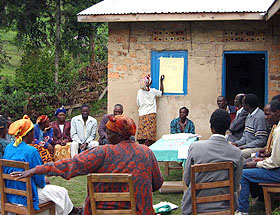 |
||||||||||||||||||||||||||||||
Uganda
Sloping terraces on steep slopes Research work has involved a wide range of experts and topics. NARO institutes at Namulonge (NAARI), Kawanda (KARI), and FORRI took the lead during 1998-2001 where researchers from NARO's bean, wheat, sorghum and maize, potato, soils and agroforestry programs were involved. Recent attachment has been to the Katchwekano ARDC of NARO's outreach program. There have been strong NGO links to Africare, CARE, Africa 2000 Network and the Kabale Farmers Association (KADFA) in Kabale. Research fellows from CIAT (sociology), TSBF/Makerere (soils) and CIP (IPM) have been based in Kabale at various 2-3 year periods between 1996-2002. A number of projects have provided targeted support in development communications (IDRC), rural sociology (DFID and PRGA), soil management and community-based approaches (IDRC). ASARECA networks: ECABREN, PRAPACE, AFRENA work in this site and ICRAF, CIAT, TSBF and CIP are also involved. Kabale's major issues are: lack of cash sources, distant and untapped markets, poor soil fertility (N, some places P and K), soil conservation issues (soil creeping and poor bund management), lack of trees and firewood, social issues (drunken men), and fragmented land (dispersed ownership). The system here is indicative of much of Rwanda and E. Congo. The hillside/valley configuration and associated land use issues presents a good case scenario for participatory community watershed management where there is a high level of fragmentation. The research work starting in 1999 was organized around 4 task forces: (1) on intensification and diversification; (2) soil management; (3) dissemination (includes seed systems) and (4) policy. There has been a dearth of research in Kabale so AHI is supporting work on alternative land use (to low yielding sorghum), increasing the cash and food crop options (wheat, climbing beans, new sorghum varieties, maize), and linking crop husbandry to improved soil management. Integrated pest management has been featured since 1995, on potato bacterial wilt (CIP and NARO) and bean root rot (CIAT and NARO). Strategic research continues on the latter with CIAT, NARO and Makerere. The policy work is concentrating on by-law revision and understanding NRM conflicts and their resolution. Seed systems work where local entrepreneurs manage multiplication and sales/dissemination was fostered in 1997 by the CIP research fellow and NARO and continues to be very successful today. Climbing bean adoption is another success story in the area, and has been jointly fostered by AHI, NARO, CIAT, Africare and the extension services. Some of the project details include:
NRM issues include:
Kapchorwa is a north-facing district situated on Mt. Elgon, spanning a wide range of altitudes from the peak of the mountain to the lowlands. AGILE's area of interest lies in agricultural lands high on the mountain and adjacent to national park boundaries where residents from highland and lowland areas are farming under the stress of land tenure insecurity related to park boundary disputes. Relatively unsustainable farming practices, low enterprise diversity, extremely limited use of conservation structures on very steep hillsides, limited use of crop rotation and soil fertility amendments are causing low yields, large amounts of soil loss and siltation in the lowlands and human nutritional deficits. The area is remote, with poor road access and limited markets. The multiple challenges faced by the local population must be viewed in the context of land insecurity, limited assistance from government and other development actors, but relatively strong local commitment to improve livelihoods, the environment and their engagement with outside actors. Bundibugyo district lies within the western Albertine Rift, on the slopes of the Rwenzori mountain ranges in south-western Uganda. It borders Kabarole District (Uganda) and the Democratic Republic of Congo (DRC). The District is characterised by an extremely rugged terrain (steep hills and V-shaped valleys) and highly erosive and degraded agricultural landscapes. It is endowed with rich biodiversity in the Semliki and Rwenzori Mountain National Parks, both home to various endemic plant and animal species. It receives relatively high rainfall (1500-2000 mm annually), which together with unstable geological formations causes frequent landslides. The District is one of the remotest in Uganda, having only one dry-weather access road, poorly developed market infrastructure, limited presence of NGOs and service providers, and poor socio-economic amenities. Consequently, local people face unprecedented poverty, limited support from development agencies and untapped income-generating potentials. |
||||||||||||||||||||||||||||||
